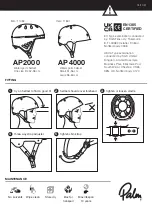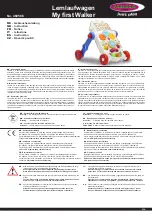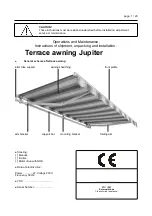
SCANNING DIFFERENT SURFACES
Freshly painted walls:
May take one week or longer
to dry after application.
Wallpaper:
The StudSensor
™
L
70 functions normally
on walls covered with wallpaper or fabric, unless the
materials are metallic foil, contain metallic fibers, or are
still wet after application. Wallpaper may need to dry for
several weeks after application.
Extremely textured walls or acoustic ceilings:
When scanning a ceiling or wall with an uneven surface,
place thin cardboard on the surface to be scanned and
scan over the cardboard. Calibrate, with cardboard in
place, in DeepScan
®
mode.
Wood flooring, subflooring, or
gypsum drywall over plywood
sheathing:
Use the DeepScan
®
mode and move the tool slowly.
The Signal Strength Indicator may
only display 1 or 2 bars when the
tool locates a stud through thick
surfaces.
Lath & plaster:
Due to
irregularities in plaster thickness,
this tool is not recommended for
use on lath & plaster.
StudSensor
™
L
70 cannot scan for
studs and joists through concrete
or carpeting and pad. In StudScan
mode, the StudSensor
™
L
70 will
NOT be able to scan through dense
materials such as glass, ceramic
tile, and foil.
Note: Sensing depth and accuracy can vary due to
moisture, content of materials, wall texture, and paint.
Indoor use only.
Electrical field locators
may not detect live AC
wires if wires are more than 50 mm from the
scanned surface, in concrete, encased in conduit,
present behind a plywood shear wall or metallic
wall covering, or if moisture is present in the
environment or scanned surface.
DO NOT ASSUME THERE
ARE NO LIVE ELECTRICAL
WIRES IN THE WALL. DO NOT TAKE ACTIONS THAT
COULD BE DANGEROUS IF THE WALL CONTAINS
A LIVE ELECTRICAL WIRE. ALWAYS TURN OFF THE
ELECTRICAL POWER, GAS, AND WATER SUPPLIES
BEFORE PENETRATING A SURFACE. FAILURE TO
FOLLOW THESE INSTRUCTIONS MAY RESULT IN
ELECTRIC SHOCK, FIRE, AND/OR SERIOUS INJURY
OR PROPERTY DAMAGE.
Always turn off power when working near
electrical wires.
Do not rely exclusively on
the detector to locate items
behind the scanned surface. Use other information
sources to help locate items before penetrating
the surface. Such additional sources include
construction plans, visible points of entry of pipes
and wiring into walls, such as in a basement, and
in standard 41 and 61 cm stud spacing practices.
3. TURNING ON/CALIBRATING THE TOOL
Place StudSensor
™
L
70 flat against the wall, then press
and hold the Power button. The LCD will illuminate
and display all icons until calibration is complete. Upon
completion of calibration, the SpotLite
®
Pointer and
buzzer will momentarily activate and the tool will begin
continuous measurements.
Note: It is important to wait for calibration to
complete (1–2 seconds) before moving the scanner.
ACT
™
(Auto Correcting Technology):
During
scanning, the tool will provisionally recalibrate itself
when needed. This recalibration is usually transparent
and no indication is made. If an arrow icon illuminates,
the tool was calibrated near or over a stud and then
moved away. The arrow indicates the direction of the
missed stud.
The Zircon StudSensor
™
L
70 OneStep
™
detects both the
centre and edges of wood and metal studs and joists in
walls, floors, and ceilings in one step. It features a
backlit display, low battery indicator, and patented
SpotLite
®
Pointer. WireWarning
®
detection also
automatically detects and alerts you of live AC wires.
1. INSTALLING THE BATTERY
Push in the battery door tab
at the bottom of the tool and
open the door. Insert a
new
9V
battery, matching the positive (+)
and negative (-) terminals to the icons
printed on the back. Snap the battery
into place and replace the door.
Low Battery Indicator:
The Low Battery Indicator
icon displays when the battery level is getting low.
While the tool will still operate, the battery will need to
be replaced soon. When the battery icon begins to flash
and is the only icon displayed on the screen, the battery
level is too low and not sufficient to power the tool for
proper operation. Please replace the 9V battery with a
brand new battery immediately.
2. OPERATING TIPS
For optimum scanning results, it is important to
properly hold StudSensor
™
L
70 and move slowly when
scanning. The following tips will provide more accurate
scanning results:
• Grasp the handle with your thumb on one side
and your fingers on the other side. Make sure your
fingertips are resting on the tool and not touching
the surface being scanned or the scanning head of
the tool.
• Hold the tool straight up and down, parallel to the
studs, and do not rotate the tool.
SpotLite
®
Pointer
Signal
Strength
Indicator
Backlit LCD
Display
Battery Door Tab
Edge/Centre
Indication
Low Battery
Indicator
Auto
Correcting
Indication
Target
Indication
Bars
AC
WireWarning
®
Detection
Indicator
StudScan/
DeepScan
®
Mode
Indicators
Power
Button
LIMITED 2 YEAR WARRANTY
Zircon Corporation, (“Zircon”) warrants this product to be free from defects in materials and workmanship for two years from
the date of purchase. Any in-warranty defective product returned to the place of purchase with proof of purchase date will be
replaced at retailer’s option.
This warranty is limited to the electronic circuitry and original case of the product andspecifically excludes damage caused
by abuse, unreasonable use or neglect. This warranty is in lieu of all other warranties, express or implied, and no other
representations or claims of any nature shall bind or obligate Zircon. Any implied warranties applicable to this product are
limited to the two year period following its purchase.
IN NO EVENT WILL ZIRCON BE LIABLE FOR ANY SPECIAL, INCIDENTAL OR CONSEQUENTIAL DAMAGES RESULTING FROM
POSSESSION, USE OR MALFUNCTION OF THIS PRODUCT.
www.ZirconEurope.com
© 2015 Zircon Corporation • P/N 66781 • Rev A 02/15
• Keep the tool flat against the wall and do not rock
or tilt the tool when slowly sliding across the surface
being scanned.
• Avoid placing your other hand, or any other part of
your body, on the surface being scanned. This will
interfere with the tool’s performance.
• If you're receiving erratic scanning results, it may be
a result of humidity, moisture within the wall cavity
or drywall, or recently applied paint or wallpaper that
hasn't fully dried. While the moisture may not always
be visible, it will interfere with the tool's sensors.
Please allow a few days for the wall to dry out.
• Depending on the proximity of electrical wiring or
pipes to the wall surface, the scanner may detect them
in the same manner as studs. Caution should always
be used when nailing, cutting, or drilling in walls,
floors, and ceilings that may contain these items.
• To avoid surprises, remember that studs or joists are
normally spaced 41 or 61 cm apart and are 38–45 mm
in width.
Anything closer together or a different
width may not be a stud, joist, or firebreak.
Always turn off power when working near
electrical wires.
ACT, DeepScan, OneStep, SpotLite, StudSensor, WireWarning, and Zircon are registered trademarks or trademarks of Zircon Corporation.
All LCD segments turn on at
the same time and the tool
beeps continuously.
Detects other objects
besides studs.
You suspect electrical
wires, but do not
detect any.
Flashing Low Battery Indicator
and tool not operating
• Unit not flat against wall.
• Unit tilted or lifted during scan. (All these factors affect
proper calibration.)
• Scanning surface is too dense or too wet for unit to operate.
• Electrical wiring and metal or plastic pipes may be near
or touching back surface of wall.
• Wires are shielded by metal conduit, a braided wire layer, behind
metallic wall coverings, plywood shear wall, or other dense material.
• Wires may not be live.
• Wires deeper than 50 mm from surface might not be detected.
• Battery level too low for proper operation.
• When scanning an uneven surface, place thin cardboard on the surface to be scanned and scan over
the cardboard in DeepScan
®
mode.
• Grasp the handle with your thumb on one side and your fingers on the other side, not touching the
surface being scanned or the scanning head of the tool.
• Hold the tool straight up and down, parallel to the studs, and do not rotate the tool.
• If you are using unit on a recently taped, painted, or wallpapered wall, allow time to dry and try again.
• While unit is still on, quickly release and re-press the Power button to enter DeepScan
®
mode.
• Check for other studs equally spaced to either side 30, 41, or 61 cm apart or check for the same stud at
several places directly above or below the first finding. Studs will run straight up and down from floor to
ceiling while pipes may change direction.
• A stud reading would measure approximately 38–45 mm apart from each edge; anything larger or smaller
is most likely not a stud if not near a door or window.
• Use extra caution if the area has plywood, thick wood backing behind drywall, or thicker than normal walls.
• If a switch controls an outlet, make sure it is ON for detection, but turned off when working near
electrical wires.
Use CAUTION when nailing, sawing, or drilling into walls, floors, and ceilings where these items
may exist.
• Replace with brand new alkaline 9V battery.
8. HELPFUL HINTS
(See also Section 2, Operating Tips)
Situation
Probable Cause
Solution
7. WIREWARNING
®
DETECTION
Zircon’s WireWarning
®
detection works continuously.
When live AC voltage is detected, the AC WireWarning
®
indicator will appear in the display.
If scanning begins over a live AC wire, the AC
WireWarning
®
indicator will flash continuously. Use
extreme caution in these circumstances or whenever live
AC is present.
WARNING
4. FINDING A STUD
Always start with the scanner placed flat against the
wall, then press the Power button. Wait for beep to
confirm calibration has completed before moving the tool.
Slowly slide tool across
surface. EDGE indication will
illuminate, indicating location
of the stud edge.
Continue sliding tool.
When the centre of stud is
located with three bars
on the Signal Strength
Indicator, some segments of
the Target Indication bars,
CENTER indication, and
SpotLite
®
Pointer will all
illuminate, and the buzzer
will sound.
In cases of deeper studs
(thicker walls), when the centre
of the stud is located only one
or two bars will show on
the Signal Strength Indicator
and only some segments of
the Target Indication bars will
illuminate. If you still can’t
locate a stud, try the next step.
Note: The tool may detect other objects behind the wall
such as pipes and conduit. See Section 2: Operating Tips
for ways to confirm that you found a stud.
5. DIFFICULTY LOCATING A STUD?
TRY DEEPSCAN
®
MODE
If you have difficulty locating a stud after following
Section 4, it could be that the stud is deep (the walls
are thick). With the unit still placed flat against the
wall and turned on, quickly (within one second)
release and re-press the Power button. The StudScan
mode indication will turn off and the DeepScan
®
mode
indication will turn on,
indicating that the tool
has entered DeepScan
®
mode. The centre of a
very deep stud will be
indicated by some
segments of the Target
Indication bars illuminating.
6. MARKING THE CENTRE OF THE STUD
Once an object is located, mark the location where
the SpotLite
®
Pointer illuminates. This is the centre of
the stud.
GB
StudSensor
™
L70
OneStep
™
Centre-Finding Stud Finder
WARNING
WARNING
Visit www.ZirconEurope.com for the most current instructions.
ZirconCorporation
ZirconTV
ZirconTools
|
ZirconToolPro
ZirconTools
























